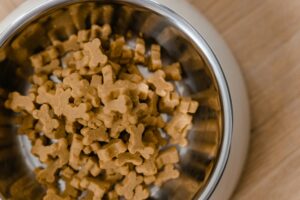When it comes to our furry companions, we only want the best for them, including their toys, treats, and cozy beds. However, the most important aspect to our pups’ life is their food.
Many of us stick to the same brand or type of dog food out of convenience or habit, but have you ever stopped to consider if it truly meets your dog’s needs?
In this guide, we will discuss how to safely and healthily transition to a new dog food and why it may benefit your dog’s health and well-being.
How to Change Your Dog’s Food
These food transitions should happen over 5-7 days to allow your dog’s digestive system to adjust gradually. Follow these steps for a successful transition:
Day 1-2: Mix 75% old food with 25% new food
Day 3-4: Mix 50% old food with 50% new food
Day 5-6: Mix 25% old food with 75% new food
Day 7+: Feed only the new dog food
The best way to know if your dog is adjusting correctly is to monitor their stool during the process, and consult with your veterinarian if you have any concerns.

Why Change Your Dog’s Food?
Changing your dog’s food may seem unnecessary, but it can benefit your furry friend. Here are some reasons as to why you should consider switching foods:
- Improved Nutrition: Different brands and types of dog food offer varying levels of nutrition, so switching to a higher-quality food can greatly benefit your dog’s overall health and well-being.
- Allergy Management: Some dogs may develop allergies or sensitivities to certain ingredients in their current food, causing skin irritation and digestive issues. Switching to a different brand or type of food can help alleviate these issues.
- Preventing Boredom: Like humans, dogs can get tired of eating the same thing daily. Switching up their food can provide variety and prevent them from getting bored with their meals.
- Age and Life Stage: As your dog ages, their nutritional needs may change (puppy food vs. adult food vs. senior food). Switching to a food specifically formulated for their age and life stage can help support their changing needs.
So next time you reach for your dog’s food, consider making a change for their health and happiness.
How to Find a Similar Formula When Changing a Dog’s Food
When switching to a new dog food, finding a similar formula that will meet your dog’s nutritional needs is important. Look for foods with the same main protein source and nutrient levels as their current food to ensure an easier transition on your dog’s digestive tract.
If you’re unsure which food is best for your dog, consult your veterinarian for recommendations based on their specific needs. Remember, always introduce any new food gradually and monitor your dog’s response; soon, they will thrive on their new diet.
Also, feel free to try different brands or types of food until you find the perfect fit for your dog.
Common Dog Food Transition Challenges & Fixes
Despite our best efforts, a dog may still have issues when transitioning to new food. Here are some common problems and how to solve them:
- Diarrhea or Vomiting: If your dog experiences diarrhea or vomiting during the transitioning process,it could be due to the sudden change in their diet, try a slower transition or put your dog on a bland diet for a few days.
- Refusal to Eat: Some dogs may refuse to eat the new food, especially if it looks or smells different from their usual food. In this case, try mixing in small amounts of their old food to entice them more.
- Lethargy or Low Energy: If your dog seems unusually lethargic or has low energy during the transition, it could be due to a lack of proper nutrition. Consult with your veterinarian if this persists, the new food may be bad!
The Proof is in the Poop!
One of the most telling signs that your dog’s new food is a success is in their poop. A healthy dog should have small, firm stools that are easy to pick up and do not smell excessively. If you notice any changes in your dog’s stool, it could indicate an issue with their new diet.
However, don’t worry if there are minor changes in their stool during the transition process. As long as your dog is eating and behaving normally, it’s likely just a result of their digestive system adjusting to the new food!
How to Choose a Dog Food
When choosing dog food, there’s no “perfect” solution. It’s important to consider your dog’s needs and preferences before deciding. These are some factors to consider:
- Ingredients
- Nutritional content
- Life stage and age
- Allergies and sensitivities
- Cost
Do your research, read reviews, and consult with your veterinarian to make the best choice for your furry friend.
Conclusion
Switching to new dog food may seem daunting, but it’s a beneficial change for your furry friend that can benefit them in the long term!
Follow the gradual transition process over 5-7 days and monitor your dog’s response. Remember to choose a food that meets your dog’s needs and consult your veterinarian for recommendations if needed.




